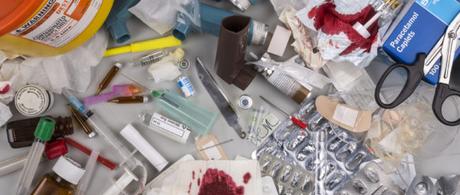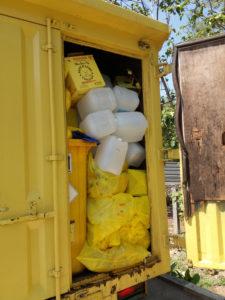
There are many different types of medical waste, categorised largely by the types of materials uses and the waste disposal methods. In general, in the UK medical waste is separated into two main types: hazardous and non-hazardous. In the US and other parts of the world, there are four major types of medical waste: General, Infectious, Hazardous and Radioactive.
Many of the same types of medical waste have different names that can be used interchangeable, depending on which country you are operating in.
 What is medical waste?
What is medical waste?
Medical waste is any waste that is generated as a by-product of healthcare work at doctor's surgeries, dentists, hospitals and laboratories. It includes any material that could come into contact with the body during diagnosis, research, drug administration or any type of treatment.
It's likely to be infectious, or potentially infectious, and is often contaminated with bodily fluids in some way - but the term can also be used to refer to general waste from any medical practice, as well as specific waste streams typically found in the medical industry.
Names and categorisations for the different types of medical waste
Each country names and categorises their medical waste slightly differently, but often the terms can be used interchangeably. Those in most widespread use include:
Medical waste in the USA:
The 1988 Medical Waste Tracking Act defines and categories solid medical waste in the following ways.
- General Waste - The bulk of most medical waste, mostly typical household and office waste
- Infectious Waste - Any waste that could cause an infection in humans, like blood, human tissue or anything contaminated with bodily fluids
- Hazardous Waste - Waste that's dangerous, but not infectious, like sharps, discarded surgical equipment, and some chemical waste
- Radioactive Waste - Any waste generated as a result of radioactive treatments, like cancer therapies, and medical equipment that uses nuclear elements.
Healthcare waste in the UK:
The UK government segregates the different types of medical waste into these categories:
- Infectious Waste - Any waste generated from the treatment of individuals or contaminated with any infectious bodily fluids
- Cytotoxic / Cytostatic Waste - Drugs and other types of medicine that are cytotoxic and/or cytostatic, or items that come into contact with any toxic or carcinogenic medicine.
- Medicinal Waste - All types of medicine, pills and creams that are not cytotoxic and/or cytostatic
- Anatomical Waste - All waste from a human or animal, including body parts, blood bags and organs
- Offensive Waste - Any waste that's non-infectious, including sanitary and nappy waste.
- Domestic or Municipal - All other general, non-clinical waste
World Health Organisation (WHO) medical waste classifications:
The WHO has issued its own guidelines on the different types of medical waste, which include:
- Infectious Waste - Anything that's infectious or contaminated
- Sharps - Waste like needles, scalpels, broken glass and razors
- Pathological Waste - Human or animal tissue, body parts, blood and fluids
- Pharmaceutical Waste - Unused and expired drug or medicines, like creams, pills, antibiotics
- Genotoxic Waste - Cytotoxic drugs and other hazardous toxic waste, that's carcinogenic, mutagenic or teratogenic.
- Radioactive Waste - Any waste containing potentially radioactive materials
- Chemical Waste - Liquid waste, typically from machines, batteries and disinfectants
- General/Other Waste - All other, non-hazardous waste.
Understanding the most common types of medical waste
Although there are several ways to categorise and name medical waste, the different medical waste streams are all fairly similar. Once you understand the types of waste within each, you can ensure each type is disposed of correctly.
For example:- All needles, scalpels, razor blades and any other sharp objects are generally referred to as Sharps. How they have been used will determine which type of medical waste they are categorised as - generally infectious, or
- Any body parts, human tissue or bodily fluid - as well as swabs and cultures - is typically referred to as anatomical or This is generally known as biohazard waste.
- The vast majority of medicines can be categorised into general pharmaceutical or medical waste - unless they are cytotoxic or cytostatic.
- Gloves, aprons, gowns, and used plastic packaging (like empty syringes and IVs), bandages and gauzes will be hazardous/offensive waste - if the patient isn't infected with any disease (also known as trace-chemotherapeutic waste), or it will be designated infectious waste if there is a risk of contamination.
Separating medical waste streams for safe disposal
It is vital to understand the different types of medical waste and separate them accordingly, in order to protect healthcare workers and other patients, and to dispose of the waste safely and effectively.
Different types of medical waste require different disposal techniques to ensure that any infectious materials cannot contaminate or spread to other areas.
Some general medical waste can be disposed of in landfill. Some requires specialist treatment such as a medical incinerator.
The vast majority of medical waste must be incinerated to ensure that all traces of infections or pathogens are completely destroyed.
Our extensive range of medical incinerators can safely destroy any waste from types 1 to 4, helping you effectively stay on top of your medical waste disposal on site.

